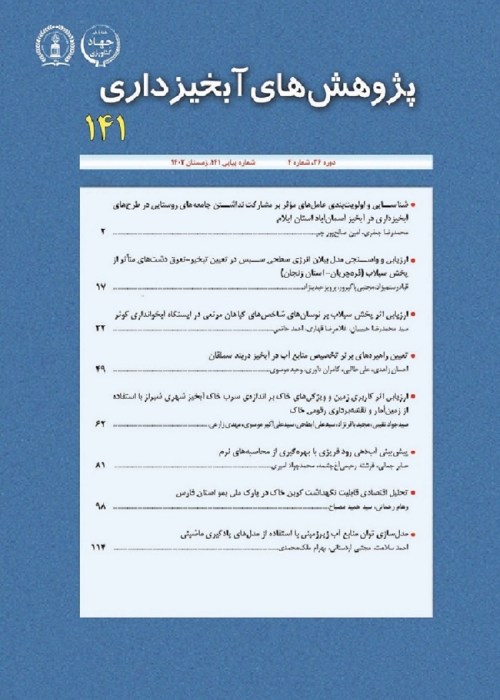Evaluation of Hydrological Response Extraction Models in Laboratory Watershed
Given the application of hydrological response in a watershed, various methods have been used to determine this response and the results have shown a high degree of accuracy and accuracy variability depending on the data used. By reviewing and summarizing the results of research carried out in the modeling of rainfall-runoff, particularly the time-area method, it was found that in most of these studies, the concept of watershed time concentration was used, which in most of the formulas used, the physical properties of the watershed were used and the dependence of time concentration on rainfall conditions was not studied. Therefore, this study was conducted to evaluate these methods using the kinematic wave method in the GIS environment, the HEC-1 method, and optimization methods using genetic algorithms in a V-shaped experimental watershed.
Observational data available in the V-shaped experimental watershed of the University of Illinois was used for rainfall-runoff modeling. The studied watershed had an impermeable aluminum surface and two uniform side sheets with a one-sided slope towards the channel with a constant value of 1%. In addition, a central channel with a one-sided slope towards the outlet of the watershed with a constant value of 1% was present. The roughness coefficient in this watershed was determined based on trial and error at 0.014.
After preparing the time-area histogram of the watershed using each of the mentioned methods, the corresponding outflow hydrographs of the watershed were determined. Then, the results were compared with observational data, and various components of the computational hydrographs were also examined. The results showed that the performance of the genetic algorithm in determining the peak time of the hydrograph with a 15% relative error was better than the performance of the kinematic wave and HEC-1 models. Additionally, the genetic algorithm model had the highest correlation coefficient with observational hydrographs with an average Nash-Sutcliffe Index of 0.968 and an average correlation coefficient of 0.983. Furthermore, by fitting the curve to the modeling results, an equation was obtained to determine the equilibrium time of the watershed relative to rainfall intensity, with a determination coefficient of 0.999. This equation expresses the inverse relationship between equilibrium time and rainfall intensity (with a power of 0.33), i.e., doubling the rainfall intensity reduces the equilibrium time by 20%. Finally, the coefficient of the equation determining the equilibrium time for this watershed was found to be 495.2, and for each rainfall intensity, its corresponding equilibrium time can be calculated with high accuracy.
In this study, under experimental watershed conditions, rainfall-runoff modeling was performed with three categories of events and three categories of different rainfall durations, each event category having four different rainfall intensity sizes. Corresponding hydrographs were obtained for each event by examining the computational hydrographs and comparing them with observational hydrographs, and it was found that the three models had one to two percent relative error in determining the maximum runoff, but in determining the time to reach the hydrograph peak, the kinematic wave and HEC-1 models had an average error of 44%. Finally, using the correlation and Nash-Sutcliffe coefficients, it was determined that the computational hydrographs produced by the genetic algorithm method were closer to the observational hydrographs and had a higher degree of correlation. It is worth mentioning that in this experimental watershed, the dependence of equilibrium time on rainfall intensity in impermeable conditions was confirmed. It is recommended that the effect of infiltration or changes in surface roughness and the determination of the dependence size be investigated.
- حق عضویت دریافتی صرف حمایت از نشریات عضو و نگهداری، تکمیل و توسعه مگیران میشود.
- پرداخت حق اشتراک و دانلود مقالات اجازه بازنشر آن در سایر رسانههای چاپی و دیجیتال را به کاربر نمیدهد.



